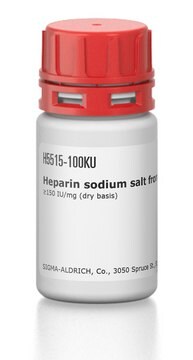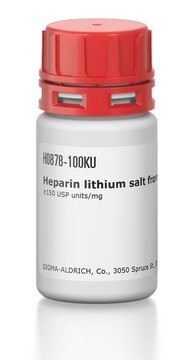2106
Heparin sodium salt from porcine intestinal mucosa
endotoxin, free
Sign Into View Organizational & Contract Pricing
All Photos(1)
About This Item
Recommended Products
biological source
Porcine intestinal mucosa
Quality Level
form
powder
usage
sufficient for 5 mL blood anticoagulant
packaging
preweighed vial of 300 USP units
impurities
endotoxin, free
color
beige
solubility
water: soluble 50 g/L
acetone: insoluble
alcohol: insoluble
benzene: insoluble
chloroform: insoluble
diethyl ether: insoluble
compatibility
for use with E-Toxate™
storage temp.
room temp
Looking for similar products? Visit Product Comparison Guide
Application
Heparin sodium salt from porcine intestinal mucosa has been used as a M199 medium supplement used for maintaining human umbilical vein endothelial cells.
Biochem/physiol Actions
Heparin sodium salt is the salt form of heparinic acid and is a polymer classified as a mucopolysaccharide or a glycosoaminoglycan. It is an anticoagulant that produces its major anticoagulant effect by activating antithrombin. Heparin binds to antithrombin III, a naturally occurring plasma protease inhibitor and accelerates significantly the rate at which antithrombin III (AT-III) inhibits coagulation proteases (factor Xa and thrombin). Additionally, it also facilitates the stabilization and regulation of tryptase as an enzymatically active tetramer.
Caution
Not for injection.
Other Notes
To gain a comprehensive understanding of our extensive range of Polysaccharides for your research, we encourage you to visit our Carbohydrates Category page.
Legal Information
E-Toxate is a trademark of Sigma-Aldrich Co. LLC
Storage Class
11 - Combustible Solids
wgk_germany
WGK 2
flash_point_f
Not applicable
flash_point_c
Not applicable
ppe
Eyeshields, Gloves, type N95 (US)
Choose from one of the most recent versions:
Already Own This Product?
Find documentation for the products that you have recently purchased in the Document Library.
Customers Also Viewed
Mechanism of the anticoagulant action of heparin.
I Björk et al.
Molecular and cellular biochemistry, 48(3), 161-182 (1982-10-29)
Nada M S Al-Saffar et al.
British journal of cancer, 119(9), 1118-1128 (2018-11-01)
AKT is commonly overexpressed in tumours and plays an important role in the metabolic reprogramming of cancer. We have used magnetic resonance spectroscopy (MRS) to assess whether inhibition of AKT signalling would result in metabolic changes that could potentially be
Overexpression of Functional SLC6A3 in Clear Cell Renal Cell Carcinoma.
Jennifer Hansson et al.
Clinical cancer research : an official journal of the American Association for Cancer Research, 23(8), 2105-2115 (2016-09-25)
Circulation, 55(2), 423-426A-423-426A (1977-02-01)
Presently available data indicate that low-dose heparin will significantly diminish postoperative deep venous thrombosis and pulmonary embolism in patients over the age of 40 subjected to major elective abdomino-thoracic surgery. The schedule is 5,000 USP units of heparin subcutaneously beginning
L B Schwartz et al.
The Journal of biological chemistry, 261(16), 7372-7379 (1986-06-05)
Tryptase was shown to be stabilized as an enzymatically active tetramer by association with heparin and dissociated to inactive monomers in the absence of heparin at 37 degrees C in physiologic buffer and in plasma. There was a 50% loss
Our team of scientists has experience in all areas of research including Life Science, Material Science, Chemical Synthesis, Chromatography, Analytical and many others.
Contact Technical Service







